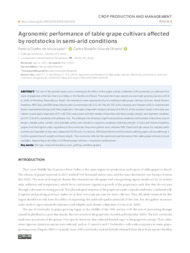Agronomic performance of table grape cultivars affected by rootstocks in semi-arid conditions.
Agronomic performance of table grape cultivars affected by rootstocks in semi-arid conditions.
Author(s): LEAO, P. C. de S.; OLIVEIRA, C. R. S. de
Summary: The aim of the present study was to investigate the effect of the grape cultivar combined with rootstocks on yield and fruit traits of grapevine in the São Francisco Valley, in the Northeast of Brazil. The experiment was carried out over eight growing seasons (2014 to 2018) in Petrolina, Pernambuco, Brazil. The treatments were represented by five seedless table grape cultivars (A Dona, Arizul, Marroo Seedless, BRS Clara, and BRS Maria Bonita) and six rootstocks (IAC 313, IAC 766, IAC 572, SO4, Harmony, and Paulsen 1103) in a randomized block experimental design with three replicates. Principal component analysis showed that 59.2% of the variation found in the data was related to principal component (PC) 1 (42.76%) associated with the number of bunches and berry weight, length, and diameter variables; and PC 2 (16.4%) correlated with yield per vine. The yield per vine showed a significant positive correlation with number of bunches, bunch length, soluble solids content, and titratable acidity, and showed a negative correlation with berry length. A Dona and Marroo Seedless grapes had the highest yield, regardless of the rootstocks they were grafted onto, whereas BRS Clara had high values for soluble solids content and titratable acidity and a balanced SS/TA ratio. In contrast, BRS Maria Bonita had the lowest yielding grape cultivar, although it had the greatest bunch weight and berry length. The rootstocks affected the agronomic performance of the table grape cultivars in most variables, depending on the effect of different grape cultivars × rootstock combinations. Key words: Vitis spp., tropical viticulture, scion, grafting, seedless grapes.
Publication year: 2023
Types of publication: Journal article
Unit: Embrapa Semi-arid Region
Observation
Some of Embrapa's publications are published as ePub files. To read them, use or download one of the following free software options to your computer or mobile device. Android: Google Play Books; IOS: iBooks; Windows and Linux: Calibre.
Access other publications
Access the Agricultural Research Database (BDPA) to consult Embrapa's full library collection and records.
Visit Embrapa Bookstore to purchase books and other publications sold by Embrapa.

